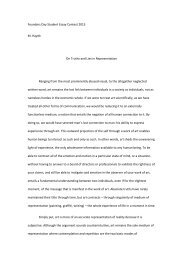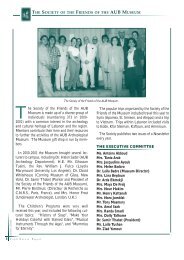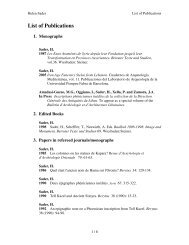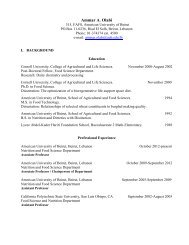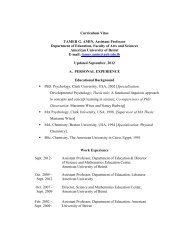The IX t h Makassed Medical Congress - American University of Beirut
The IX t h Makassed Medical Congress - American University of Beirut
The IX t h Makassed Medical Congress - American University of Beirut
You also want an ePaper? Increase the reach of your titles
YUMPU automatically turns print PDFs into web optimized ePapers that Google loves.
and nurses in a telephone survey (response rate: 53% <strong>of</strong> 100 emergency departments – ED - for<br />
adults): lack <strong>of</strong> available nursing staff, inability to monitor central venous pressure in the ED and<br />
challenges in identifying septic patients were the most frequent; 16% <strong>of</strong> physicians also endorse<br />
lack <strong>of</strong> agreement with the EGDT protocol (11). A questionnaire survey conducted in France in<br />
2008 has given the following results: 83% <strong>of</strong> pediatric intensivists and 91% <strong>of</strong> the pediatricians <strong>of</strong><br />
the pediatric retrieval systems used a written sepsis protocol; the main barriers to implementing<br />
the surviving sepsis guidelines were monitoring <strong>of</strong> ScvO 2 (76%), collaboration between ED and<br />
PICU (27%) and access to a sepsis protocol (24%) for the pediatric intensivists, and monitoring<br />
<strong>of</strong> ScvO 2 (89%), central catheter insertion and monitoring central venous pressure (CVP) (33%)<br />
for the pediatricians <strong>of</strong> the pediatric retrieval systems (12). In the study by Oliveira et al, the most<br />
important barriers in implementing the ACCM/PALS guidelines were lack <strong>of</strong> adequate vascular<br />
access, lack <strong>of</strong> recognition <strong>of</strong> early shock, shortage <strong>of</strong> health care providers and non-use <strong>of</strong><br />
goals and treatment protocol (8). In brief, these studies have identified numerous and important<br />
barriers to the optimal resuscitation <strong>of</strong> patients with severe sepsis.<br />
3. Is early goal therapy largely adopted or criticized 9 years after the publication by Rivers et al?<br />
<strong>The</strong> EGDT has been frequently criticized (5, 13, 14). In fact, if early initiation <strong>of</strong> effective antibiotic<br />
treatment and rapid fluid resuscitation is a scientifically sound concept, other elements <strong>of</strong> the<br />
“EGDT bundles” are not supported by scientific evidence, particularly the choice <strong>of</strong> CVP as a<br />
guide for fluid administration and the use <strong>of</strong> ScvO2 as the end point <strong>of</strong> resuscitation and the steps<br />
to normalize this parameter (blood transfusion and inotropes) (13). Questions about the EGDT<br />
algorithm are summarized in figure 1 (14). It is noteworthy that the incidence <strong>of</strong> low ScvO 2 values<br />
in adults with sepsis or septic shock has been reported as low as 16% (15) (this incidence was<br />
41% in the control group and 31% in the intervention group in the pediatric study by de Oliveira<br />
(10)); also, abnormally high ScvO 2 (90% to 100%) was associated with increased mortality (16).<br />
At the present time, no study has demonstrated if the reduction in mortality <strong>of</strong> patients with<br />
severe sepsis observed in many studies (5) is due to some or all bundle elements, or to other<br />
factors (17). As a consequence, some parts <strong>of</strong> the EGDT protocol are anecdotally adopted.<br />
Indeed, a recent multicentre prospective study (324 adults with severe sepsis or septic shock),<br />
in which management did not include a ScvO 2 catheter, reported a in-hospital mortality <strong>of</strong> 23%<br />
that compared favorably with that <strong>of</strong> recent EGDT trials (18). Furthermore, Jones et al recently<br />
compared lactate clearance and ScvO2 as goals <strong>of</strong> early sepsis resuscitation in 300 adults<br />
admitted with severe sepsis and septic shock and randomly assigned. <strong>The</strong>se two protocols did<br />
not result in significant different in-hospital mortality (23% in the ScvO 2 group vs. 17% in the lactate<br />
group) (19).<br />
Conclusion:<br />
<strong>The</strong>re is no doubt that early recognition and application <strong>of</strong> recommendations for the acute<br />
management are the first step toward improved outcomes <strong>of</strong> sepsis and septic shock. Early fluid<br />
resuscitation and antibiotics administration represent uncontroversial key points (20). However,<br />
other elements <strong>of</strong> the EGDT, particularly CVP and ScvO 2 , are seriously criticized. Norepinephrine<br />
in case <strong>of</strong> ineffective fluid resuscitation, early and repeated echocardiography-Doppler and<br />
dynamic indices to guide fluid resuscitation and inotropic therapy, and lactate as a marker <strong>of</strong><br />
severity and therapy responsiveness are probably supported by more scientific evidence than<br />
some EGDT elements (21). <strong>The</strong>y are included in our protocol, beside CVP and ScvO2, according<br />
to the French guidelines (22). This, however, needs further evaluation.<br />
67






